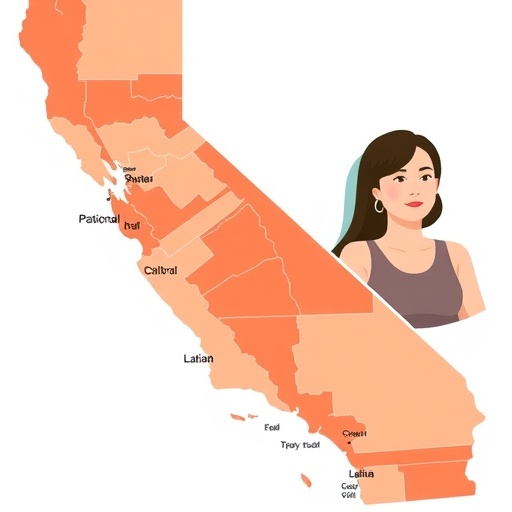In a revealing new study conducted by the UCLA Chicano Studies Research Center in collaboration with the Latina Futures 2050 Lab, profound wage disparities facing Latinas in California have come to light, exposing a persistent and severe income gap that transcends geographic and socioeconomic boundaries. This investigation sheds critical light on the economic hardships latent within one of the state’s most vibrant yet underserved demographic groups, underlining systemic inequities that demand immediate and sustained policy attention.
Latinas in California earn a mere 49 cents for every dollar earned by non-Hispanic white male counterparts, an alarming statistic that starkly illustrates the entrenched economic marginalization within the labor market. This wage gap is not uniform; it worsens significantly in affluent counties such as San Mateo, Santa Clara, and Marin, where median household incomes soar above $100,000. Here, Latinas earn only 38, 37, and 34 cents on the dollar respectively, markedly lower than the overall state average. The disparity in wealthier counties highlights a complex interaction between high living costs, localized labor dynamics, and systemic biases that disproportionately disadvantage Latinas.
The research draws from the American Community Survey (ACS) data spanning from 2019 to 2023, focusing on counties with populations exceeding 125,000 residents. This methodology ensures a comprehensive, demographic-rich analysis capable of capturing nuanced socio-economic trends across California’s diverse counties. Importantly, Latinas form the largest contingent of female workers in 14 out of the 35 counties studied, emphasizing their integral role in California’s labor force and the broader economy.
Such statistical revelations underscore a historical absence of focused research on Latinas, a gap that has stymied legislative and policy development tailored to this substantial group. The exclusion from earlier studies has contributed to a systemic invisibility that reinforces inequitable economic structures. By centering its analysis on Latinas, this study not only fills a critical knowledge void but also provides a platform for informed policy advocacy geared toward equitable economic representation.
The geographic variability in the wage gap is particularly noteworthy. In counties where median household incomes fall below $100,000, the wage disparities, while present, are less pronounced in some areas. For instance, women in Humboldt, Shasta, and Imperial counties earn 80, 78, and 74 cents per dollar respectively, compared to non-Hispanic white men. Conversely, in Santa Barbara and Los Angeles counties, which share similar median income levels, Latina earnings drop drastically to 48 and 46 cents on the dollar. This spatial heterogeneity in pay inequalities highlights the interplay of regional economic conditions, labor market characteristics, and demographic compositions.
The consequences of these disparities transcend individual earnings, impacting family welfare, community stability, and local economic vitality. Lower income levels hinder access to essential services such as quality childcare, healthcare, and affordable housing, exacerbating socio-economic stratification. These challenges are compounded by systemic issues, including limited educational and training opportunities, which restrict pathways to higher-paying employment and upward mobility for Latinas.
Addressing these entrenched disparities requires a multifaceted policy approach. According to Veronica Terriquez, the study’s co-author and director of the UCLA Chicano Studies Research Center, robust enforcement of pay equity legislation statewide must be coupled with enhanced wage transparency. Such measures are vital to holding employers accountable and enabling informed decision-making among workers. In parallel, proactive support for collective bargaining can amplify worker voices and facilitate equitable wage negotiations, particularly in industries with high Latina participation.
Furthermore, expanding educational access and vocational training tailored to emerging and higher-paying sectors is essential to dismantle structural barriers in the labor market. Proactive hiring and promotion strategies that recognize and accommodate the lived realities of Latina workers can foster inclusive and equitable workplace environments. Localized initiatives that reflect community-specific economic contexts are equally vital, given the demonstrated geographic variability in wage gaps.
The study also situates these economic inequities within a broader socio-political context marked by intensified immigration enforcement and resultant labor market volatility. This environment disproportionately affects Latina workers, often concentrated in sectors vulnerable to labor exploitation and instability. Hence, safeguarding human and constitutional rights through supportive local governance and employer practices is critical to mitigating these risks and promoting economic security.
From a technical standpoint, the analytical framework employed harnesses demographic and economic indicators within a multivariate context, allowing for granular disaggregation by ethnicity, gender, and geography. This facilitates a robust examination of wage disparities adjusted for relevant covariates, contributing to a more precise understanding of the structural determinants of income inequality.
Overall, this comprehensive appraisal of Latina wage disparities constitutes an urgent call to action for policymakers, advocates, and the academic community. The findings challenge prevailing narratives about economic progress and equality in one of America’s most dynamic states, advocating for sustained, equity-focused reforms that can transform the economic landscape for Latinas and, by extension, the entire state’s socio-economic fabric.
Subject of Research: Wage gaps and economic disparities experienced by Latinas across California counties.
Article Title: Latina Wage Gap Disparities Across California Counties: A Critical Analysis of Income Inequality
News Publication Date: Not explicitly stated in the source document.
Web References:
– UCLA Chicano Studies Research Center: https://www.chicano.ucla.edu/
– Latina Futures 2050 Lab: https://www.chicano.ucla.edu/research/latina-futures-2050-lab
– Latina Wage Gap Disparities Across California counties report: https://www.chicano.ucla.edu/publications/report-brief/latina-wage-gap-disparities-across-california-counties
Keywords: Economics, Economics research, Demography, Social research




